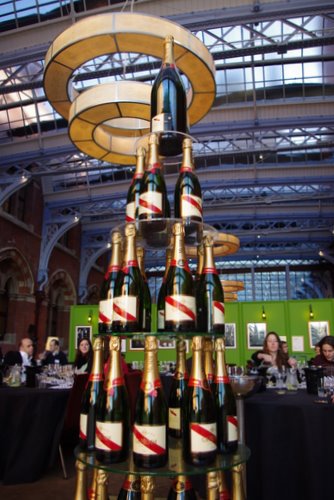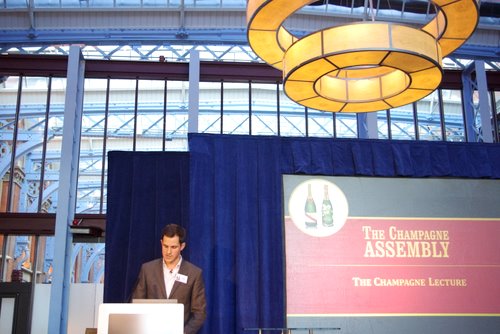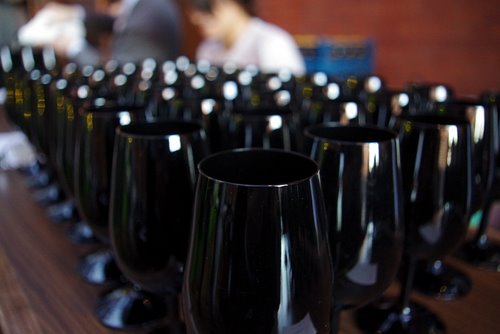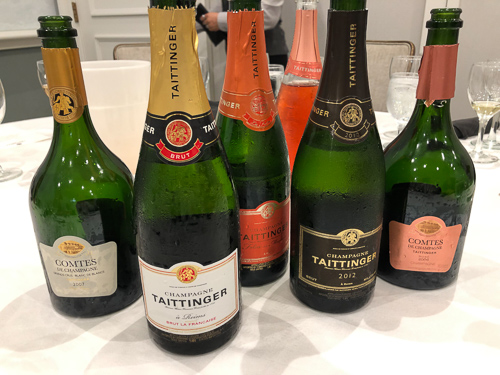Today was the Champagne Mumm/Perrier Jouet Champagne Assembly, held in the fabulous surroundings of the Marriott Renaissance Hotel at St Pancras.

I attended three of the five sessions, and they were pretty thought provoking. Physicist and food science geek Professor Peter Barham led a session looking at the effect of temperature on flavour. Basically, as temperature drops, our perception of sweetness and bitterness are both reduced. So let ice cream melt, and it tastes too sweet. Sweet wines taste fresher chilled right down.
Also, the aroma profile of food or drink changes with temperature. Some volatiles are more affected than others, so their ratio will change. That’s important. Barham introduced the new concept of thermal tasters, where some people have a semi-synaesthetic ability to taste ‘sweet’ when their warm mouth is exposed to ice cold water.
Peter used some dishes prepared by Michelin-starred chefs Jonray & Peter Sanchez-Iglesias from Casamia to illustrate this concept, serving them hot and cold with three different Mumm Champagnes. Alas, logistical challenges meant the only dish with any real temperature difference was the second of the three, and here it tasted better warm, but matched the Champagne less well (in my opinion). Some interesting concepts in this session, but too many variables to conclude anything.
The next session involved four short talks looking at the past, present and future of Champagne. Dan Jones’ potted history of Champagne set the scene for Euromonitor’s Spiros Malandrakis to give us some data on Champagne consumption. Global sales in 2011: 221 billion litres. 79% of this is consumed in Western Europe, with 12% volume growth in 2011. Interestingly, Champagne sales mirror economic growth as measured by GDP. But, even more interestingly, it seems that the trends in Champagne sales predate the economic changes. If this is a robust finding, it could have useful predictive value!
Three-quarters of Western European sales are in France, with the UK and then Germany the next most important markets. Bad news? Margins are getting thinner because of discounting, and other sparkling wines are slowly creeping up on Champagne. How bubbly is the future? If things don’t take a turn for the worse, then Malandrakis reckons 1-2% growth over the next five years.
Giles Fallowfield gave an interesting presentation on the way Champagne styles have changed over the last 200 years. Dry Champagne (Brut, Extra Brut) dominates the current market, but it’s a relatively modern thing. In 1939, half of all Champagne was still sweet, but now 85% of all sales are dry. Back in the 19th Century, Champagne was pretty much a dessert wine. Russia had the sweetest tooth, then France (160-200 g/litre sugar), and the USA (110-165 g/l sugar) – the UK was unusual in liking ‘just’ 21-60 g/l sugar. Now the dosage level in Brut is going down: Mumm Cordon Rouge recently moved from 10 to 8 g/l. Fallowfield reckons an innovation for the future could be playing with different pressure levels.

The next session, looking at sensory perception, was really fun. Professors Charles Spence (an experimental psychologist) and Barry Smith (a philosopher with a particular interest in the sense of flavour) did a tight double act examining how sensory cues other than taste and smell influence our perception of flavour.
Taste, touch, sight and smell come together to provide a unified experience of flavour. Vision, in particular, can influence flavour quite significantly. ‘People taste the flavour they see,’ says Spence. They also touched on inter-individual differences in taste perception, with the division of people into the supertaster/normal taster/non-taster categories depending on how many taste buds they have on their tongues. Smith recalled that when this work was first applied to wine, suddenly all the critics claimed to be supertasters, but he emphasized that actually you don’t want to be a supertaster because it means you could end up not liking wine all that much because of problems with acidity, bitterness and tannin.
The practical session involved tasting four Champagnes from black ISO tasting glasses. Devoid of the visual sense, could we tell which two Champagnes were from white grapes and which were from black. We all did spectacularly badly. I got one out of four right, which from discussions with colleagues seemed to be about par for the course.
5 Comments on Exploring perception at the Champagne assembly




Interesting piece Jamie, thanks.
should the consumptions figure be £221billion (not litres)?
Good thoughts on this I think. The aspects of taste/smell and perception you raise are infinately fascinating as they are open for debate; everyone will have a different opinion, irrespective of taste and palate. Have you read any of the late (and great, I think) Max Lake on the subject? He looks at a lot of these issues and more. Aside from his wine making and thinking, I regard his writings on taste and perception are amongst the best. Anyhow a good post on your much appreciated blog.
Marriot Renaissance? What a bloody awful name for such a beautiful place!
Interesting the tasting with black glasses. Recognizing a brut from a blanc de blanc from taste alone seems relatively easy to me. I must try it!